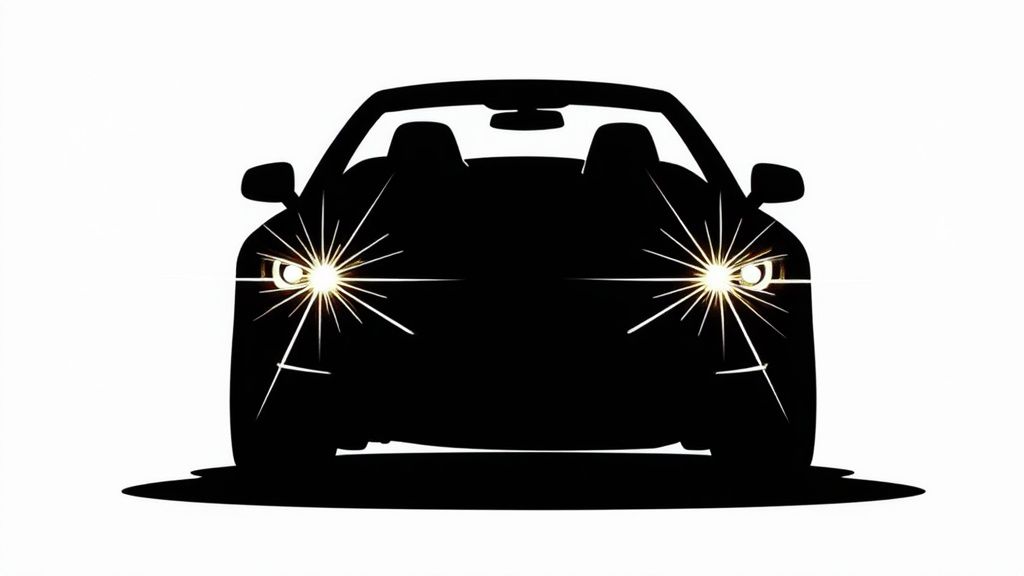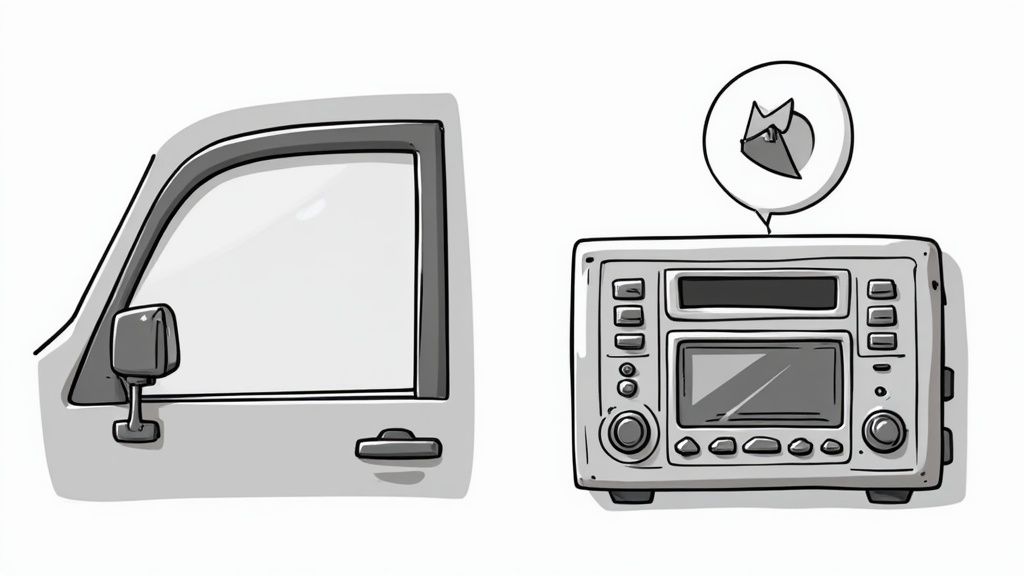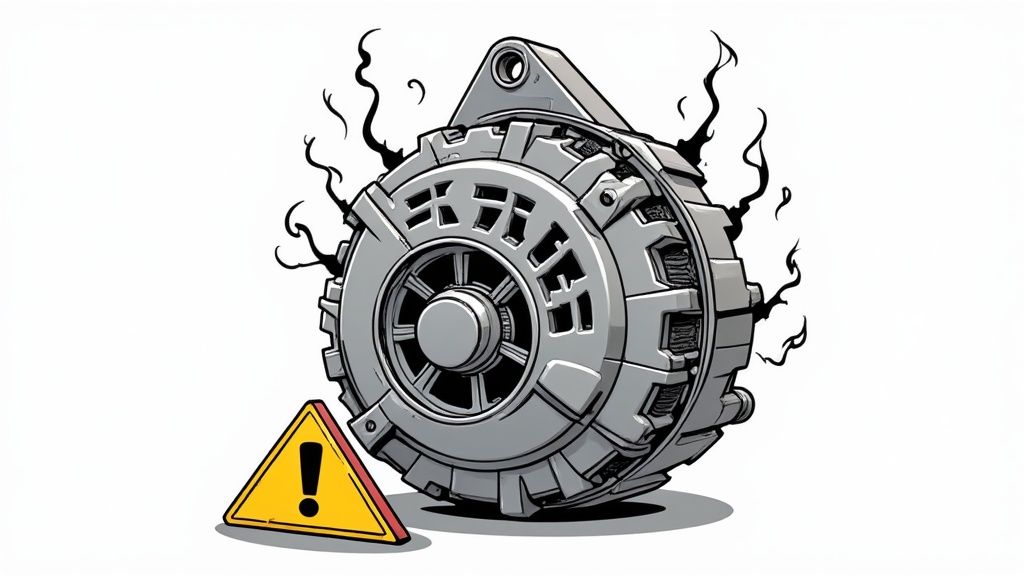
Kwik Kar Service Coupon
Get upto $20 OFF on all services.
A failing alternator can leave you stranded. This list of bad alternator symptoms helps you identify potential problems early, saving you from costly repairs and unexpected breakdowns. Learn to recognize the six critical warning signs of a failing alternator, from dim lights to burning smells, so you can address the issue promptly and keep your vehicle running smoothly. Ignoring these signs can lead to a dead battery and complete electrical system failure.
One of the most common and often earliest noticeable bad alternator symptoms is a change in the brightness of your vehicle's lights. A healthy alternator consistently supplies power to the electrical system, including the lights. However, a failing alternator struggles to maintain this consistent flow of electricity. This can manifest in several ways, ranging from lights that appear dimmer than usual to lights flickering or even, surprisingly, becoming unusually bright for short periods. The inconsistency stems from the alternator's voltage regulator malfunctioning, leading to erratic power delivery. This symptom deserves its place high on the list because it's often an early warning sign, allowing you to address the problem before it escalates and leaves you stranded.

Specifically, you might notice your headlights appearing dimmer than they should, particularly when the engine is idling. Dashboard lights might flicker or change intensity while you're driving. Interior lights could gradually fade, creating a disconcerting ambiance. Occasionally, and somewhat counterintuitively, you might observe your lights becoming very bright just before they fail completely. This is a result of the voltage regulator failing and sending a surge of power through the system.
Features of this symptom:
Pros of using this as a diagnostic indicator:
Cons:
Examples:
Tips for checking and diagnosing:
One of the most common bad alternator symptoms is a dead or weak battery. The alternator's primary function is to recharge the battery while the engine is running. It acts like the power plant of your vehicle's electrical system, constantly replenishing the energy the battery expends on starting the engine, powering lights, and running accessories. A failing alternator can't keep up with this demand, forcing the vehicle to rely solely on the battery's reserves. This continuous drain eventually leads to a dead battery, leaving you stranded. Often, a previously healthy battery that suddenly dies points to a faulty alternator rather than a battery issue itself. This makes diagnosing alternator problems tricky, as the symptoms often mimic those of a failing battery.

Several telltale signs can help you pinpoint a failing alternator as the culprit behind your battery woes. These bad alternator symptoms often include a vehicle that starts fine but then won't restart later, a battery that tests good but continues to discharge, and increasingly slow or labored engine cranking. Jump-starting might temporarily get your vehicle running, but the problem will quickly return as the alternator fails to recharge the battery. These symptoms are particularly relevant for our Richardson commuters, families, and business fleet managers who rely on dependable vehicles for daily operations. A sudden breakdown due to a dead battery can disrupt schedules and create costly delays.
For our target audience of Richardson commuters, families, military personnel, first responders, healthcare workers, and small business fleet managers, recognizing these signs early is crucial for preventing unexpected breakdowns and potential safety hazards. Imagine a first responder unable to start their vehicle after a long shift or a delivery driver stranded with a full load due to a dead battery – a failing alternator can have serious consequences.
Pros of using this method to diagnose a bad alternator:
Cons of relying solely on this symptom:
Examples of this symptom in action:
Actionable Tips for Diagnosing a Bad Alternator Based on Battery Issues:
By understanding how a bad alternator affects your battery and being aware of the associated symptoms, you can take proactive steps to address the issue before it leaves you stranded. Regular maintenance and prompt diagnosis are key to keeping your vehicle running reliably and avoiding costly repairs down the road.
One of the most common and reliable bad alternator symptoms is the illumination of a warning light on your dashboard. Modern vehicles utilize sophisticated onboard diagnostic systems that constantly monitor the charging system's performance. When the alternator's output voltage or current falls outside the acceptable parameters, these systems trigger a warning light to alert the driver. This serves as a direct indication that the charging system, and most likely the alternator, is not functioning correctly.

This warning light typically takes the form of a battery-shaped icon, or sometimes an "ALT" or "GEN" abbreviation. The warning may initially appear intermittently, especially under specific conditions like higher RPMs or when using multiple electrical accessories (headlights, radio, air conditioning). As the alternator deteriorates further, the light will likely become constant. In some cases, other warning lights might also illuminate as various electrical systems begin to malfunction due to insufficient power. This is a crucial bad alternator symptom that shouldn't be ignored.
Why This Symptom Matters
This visual cue is incredibly valuable for several reasons. First, it provides a direct indication from the vehicle's internal diagnostics, eliminating guesswork. Second, it usually appears early enough to prevent you from being stranded with a dead battery, especially valuable for our Richardson commuters, families, and those in critical roles like military personnel, first responders, and healthcare workers. Finally, it's a clear visual indicator requiring no technical expertise to understand, making it accessible to everyone, including those managing small business fleets. For owners of aging or high-mileage vehicles, this warning light can be a lifesaver, preventing further damage and costly repairs.
Features and Benefits:
Pros:
Cons:
Examples:
Actionable Tips:
By understanding this key bad alternator symptom and taking swift action, you can prevent more serious issues down the road and ensure the reliability and safety of your vehicle.
One of the most noticeable bad alternator symptoms is the erratic behavior or complete failure of your vehicle's electrical accessories. A healthy alternator consistently supplies power to all vehicle systems. However, as the alternator deteriorates, it struggles to meet the electrical demands of your car, especially when multiple systems are engaged. This power deficit initially affects non-essential electrical components, offering a valuable warning sign before complete alternator failure.

This power shortage can manifest in various ways. Features like power windows may operate slower than usual, struggling to rise or fall. Your radio, GPS, or infotainment system might unexpectedly reset, lose presets, or experience intermittent sound disruptions. Other accessories, such as heated seats, power seats, or even USB charging ports, can also malfunction, working intermittently or failing altogether. For example, your heated seats may cycle on and off unpredictably, your power seats might move sluggishly or stop mid-movement, and your smartphone may charge very slowly or not at all from the vehicle's USB ports. These seemingly minor inconveniences can be early indicators of a failing alternator.
The good news is that these accessory failures often affect non-critical systems first, giving you a window of opportunity to address the problem before it escalates. Furthermore, the simultaneous malfunction of multiple systems often points directly to alternator issues rather than individual component failures. These symptoms are easily noticeable by most drivers in everyday use, making them a relatively straightforward way to detect a potential alternator problem.
However, there are some downsides to relying solely on accessory failures as a diagnostic tool. These symptoms can sometimes be mistaken for problems with the individual components themselves, leading to potentially expensive troubleshooting of perfectly functional parts. In some luxury vehicles, sophisticated power-saving modes might mask deeper alternator problems by prioritizing essential systems and shutting down non-essential ones. This can delay the diagnosis of a failing alternator.
If you experience any of these electrical accessory issues, a simple test can help confirm whether your alternator is the culprit. While idling, turn on multiple electrical accessories, such as the headlights, radio, and heated seats. If their performance improves when you rev the engine, it suggests that your alternator is struggling to produce sufficient power at idle and is a strong indication of a potential problem. If you suspect a failing alternator, prioritize essential electrical systems like headlights and wipers, especially if you must continue driving. Document which systems are failing and when they do so; this information will be invaluable for a mechanic when diagnosing the issue. Learn more about Electrical Accessory Failures for additional information and support. Addressing this issue promptly can prevent more serious problems down the road, ensuring your safety and the longevity of your vehicle's electrical system. This is especially crucial for our target audience in Richardson, including commuters, families, military personnel, first responders, and business fleet managers, who rely heavily on their vehicles for daily operations and safety.
One of the most noticeable bad alternator symptoms is unusual noise emanating from under the hood. A failing alternator can often be identified early by the distinct sounds it produces before more serious electrical issues arise. This is because the alternator contains several moving parts, including bearings and a rotor, which can wear out or become damaged over time. These failing components often create a symphony of unwelcome sounds, ranging from high-pitched whines and squeals to deeper grinding or rattling noises. This makes recognizing these auditory clues a valuable tool in diagnosing a potential alternator problem, especially for those vigilant about their vehicle's health.
These sounds typically originate from the front of the engine where the alternator is mounted and often change in pitch or intensity with engine RPM. For example, a whining noise might directly correspond to engine speed, increasing in pitch as you accelerate. Alternatively, a squealing sound might temporarily disappear when the engine is revved and then return as the RPMs settle back down. Even a rhythmic clicking or tapping sound from the alternator area can signal an issue.
This auditory diagnostic method is particularly beneficial because it can alert you to a developing alternator problem before you experience more disruptive electrical symptoms, like dimming headlights or a dead battery. Recognizing these noises early can prevent you from being stranded unexpectedly.
Here are some specific features of alternator noise to listen for:
Pros of using sound to diagnose alternator issues:
Cons of relying solely on sound for diagnosis:
Examples of typical alternator noises:
Tips for diagnosing alternator noise:
Popular automotive YouTubers like ChrisFix and Scotty Kilmer have demonstrated alternator noise diagnosis in their videos, offering visual and auditory examples of these sounds. For a visual demonstration, you can watch this helpful video:
For Richardson commuters, families, military personnel, first responders, healthcare workers, owners of older vehicles, and small business fleet managers, recognizing these sounds can save valuable time and money by addressing a potential alternator problem before it leads to a breakdown. Learn more about Strange Noises from the Alternator and other alternator/starter services. Early diagnosis is key to preventing unexpected repairs and ensuring the reliable operation of your vehicle. Recognizing the distinctive sounds of a failing alternator is an essential first step in this process.
One of the most alarming and serious bad alternator symptoms is a burning smell or visible smoke. This signifies a severely failing alternator and requires immediate attention. Ignoring this symptom could lead to further damage and even a vehicle fire. This makes it a critical symptom to understand and act upon, especially for those who rely on their vehicles daily, such as Richardson commuters, families, military personnel, first responders, healthcare workers, and small business fleet managers.
A failing alternator can overheat due to several reasons: internal short circuits, seized bearings, or an excessive electrical load. These malfunctions can create a distinct burning odor, often described as similar to an electrical fire or burning rubber. The heat can also cause the drive belt to slip on the seized alternator pulley, creating a rubbery burning smell. In extreme cases, you might even see smoke emanating from the alternator itself, a clear indication of critical failure.
Features of a Burning Alternator:
Pros of Recognizing this Symptom:
Cons of this Symptom:
Examples:
Actionable Tips:
This symptom deserves its place on the list of bad alternator symptoms because it represents a critical and potentially dangerous failure. Recognizing this symptom and taking immediate action can prevent further damage, costly repairs, and potential vehicle fires. For Richardson residents and others who depend on their vehicles, understanding this crucial warning sign is vital for safe and reliable transportation.
| Symptom | 🔄 Implementation Complexity | 🛠️ Resource Requirements | 📊 Expected Outcomes | 💡 Ideal Use Cases | ⭐ Key Advantages |
|---|---|---|---|---|---|
| Dim or Overly Bright Lights | Low – visual observation needed | Minimal – no tools required | Early detection of alternator voltage issues | Nighttime or low-light driving visibility | Early, easy-to-notice symptom without tools |
| Dead or Weak Battery | Medium – requires voltage testing | Basic tools or free testing at stores | Identifies charging system failure quickly | When vehicle won’t restart after running | Clear sign of charging failure; easy to diagnose |
| Warning Light Illumination | Low – automatic dashboard alerts | None – vehicle provides indication | Immediate alert to charging system faults | All drivers; early warning before failure | Direct, unambiguous system warning |
| Electrical Accessory Failures | Medium – observe multiple systems | None to minimal – driver observation | Indicates alternator can’t support accessories | Daily vehicle use, non-essential components | Multiple systems failing simultaneously points to alternator |
| Strange Noises from Alternator | Medium to high – requires careful listening | Minimal – possibly mechanic tools | Early identification of mechanical failure | When unusual engine noises occur | Can isolate specific alternator component issues |
| Burning Smell or Visible Smoke | Low – sensory detection | None – requires immediate action | Clear sign of critical alternator failure | Emergency situations, overheating detected | Unmistakable sign requiring urgent attention |
Recognizing the bad alternator symptoms outlined above—from dim lights and a dead battery to unusual noises and burning smells—is crucial for maintaining your vehicle's reliability and safety. These seemingly minor issues can quickly escalate, leaving you stranded or facing costly repairs. Remember, a functioning alternator is essential for powering your car's electrical systems and recharging the battery. Ignoring these warning signs can lead to a complete alternator failure and a cascade of electrical problems. Mastering the ability to identify these symptoms empowers you to take proactive steps, preventing further damage and ensuring a smooth, uninterrupted commute for Richardson families, military personnel, first responders, and busy professionals alike. If you suspect your alternator is failing, it's crucial to address the issue promptly. A faulty alternator can lead to various electrical problems and leave you stranded. For professional diagnostics and repair, consider contacting a reputable auto repair shop specializing in alternator and starter services.
Don't let a faulty alternator disrupt your life. For reliable diagnostics, repair, and preventative maintenance, visit Kwik Kar Oil Change and Auto Care in Richardson, TX. Our ASE-certified technicians are equipped to handle all your alternator needs, ensuring your vehicle stays running smoothly and safely. Schedule your appointment today for peace of mind on the road.
CLICK LINK BELOW TO LEARN MORE ABOUT OUR SERVICES

Get upto $20 OFF on all services.

Get upto $20 OFF on all services.